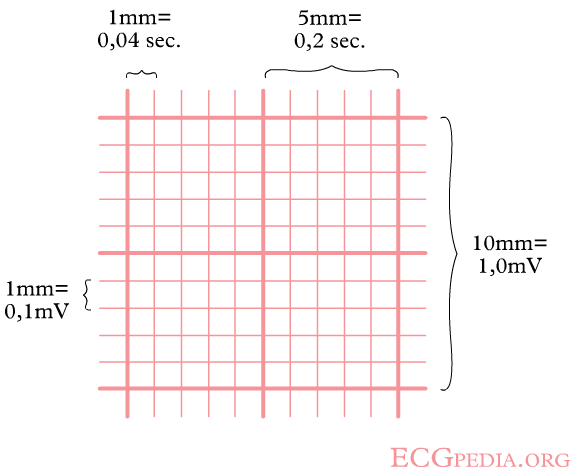Rate: Difference between revisions
No edit summary |
mNo edit summary |
||
| Line 4: | Line 4: | ||
[[Image:Ecgfreq.png|thumb| De aftelmethode om de hartfrequentie te bepalen. Het tweede QRS-complex ligt tussen de ''75'' en de ''60'' slagen per minuut. Deze hartslag ligt daar dus tussenin, rond de 65 slagen per minuut. ]] | [[Image:Ecgfreq.png|thumb| De aftelmethode om de hartfrequentie te bepalen. Het tweede QRS-complex ligt tussen de ''75'' en de ''60'' slagen per minuut. Deze hartslag ligt daar dus tussenin, rond de 65 slagen per minuut. ]] | ||
This is a easy question. To anwere this, determine the time between two QRS complexes. | |||
Previously, the ECG was registered on a paperstrip transported through an ECG writer at the speed of 25 mm/second. Nowadays, digital ECG registration is common however, the method of determining the frequency remains the same. | |||
The ECG paper has a grid with thick lines 5 mm apart (= 0,20 second) and thin lines 1 mm (0,04 second). | |||
'''There are three simple methods to determine the hart frquency (HF):''' | |||
# Count the small (1mm) lines between two QRS-complexes. Hens, the ECG paper runs with 25 mm/sec through the ECG writer, therefore: [[Afbeelding:HFformule.png]]<br> | |||
This method work fine in case of tacycardia (>100 beats/minute) | |||
# To determine the frequency of a normal sinus ritme: | |||
Use the sequence 300-150-100-75-60-50-43-37. Count from the first QRS complex, the first thick line is 300, the next line 150 etc. Stop the sequence at the next QRS complex. When the second QRS complex is in between two lines, take the mean of the two numbers from the sequence. | |||
You can finetune this method with the following more precise sequence: | |||
*'''300'''''-250-214-187-167-'''''150''' | *'''300'''''-250-214-187-167-'''''150''' | ||
*'''150'''''-136-125-115-107-'''''100''' | *'''150'''''-136-125-115-107-'''''100''' | ||
*'''100'''''-94-88-83-79-'''''75''' | *'''100'''''-94-88-83-79-'''''75''' | ||
*'''75'''''-71-68-65-62-'''''60''' | *'''75'''''-71-68-65-62-'''''60''' | ||
# Non regular ritmes are best determined with the "3 second marker method" | |||
Count the number of QRS-complexes that fitt in 3 seconds (some ECG writers register this period on the ECG paper. Multiply this number by 20 and find the number of beats/minute. | |||
{{clr}} | {{clr}} | ||
Revision as of 15:16, 28 April 2007
Some statements may be disputed, incorrect or biased. |
What is the cardiac frequency?


This is a easy question. To anwere this, determine the time between two QRS complexes.
Previously, the ECG was registered on a paperstrip transported through an ECG writer at the speed of 25 mm/second. Nowadays, digital ECG registration is common however, the method of determining the frequency remains the same.
The ECG paper has a grid with thick lines 5 mm apart (= 0,20 second) and thin lines 1 mm (0,04 second).
There are three simple methods to determine the hart frquency (HF):
- Count the small (1mm) lines between two QRS-complexes. Hens, the ECG paper runs with 25 mm/sec through the ECG writer, therefore: Afbeelding:HFformule.png
This method work fine in case of tacycardia (>100 beats/minute)
- To determine the frequency of a normal sinus ritme:
Use the sequence 300-150-100-75-60-50-43-37. Count from the first QRS complex, the first thick line is 300, the next line 150 etc. Stop the sequence at the next QRS complex. When the second QRS complex is in between two lines, take the mean of the two numbers from the sequence.
You can finetune this method with the following more precise sequence:
- 300-250-214-187-167-150
- 150-136-125-115-107-100
- 100-94-88-83-79-75
- 75-71-68-65-62-60
- Non regular ritmes are best determined with the "3 second marker method"
Count the number of QRS-complexes that fitt in 3 seconds (some ECG writers register this period on the ECG paper. Multiply this number by 20 and find the number of beats/minute.
Wat beïnvloedt de hartfrequentie?
De hartfrequentie wordt door een groot aantal factoren bepaald.
- Het autonome zenuwstelsel, de sympathicus en parasympathicus.
- Het sympathisch systeem o.i.v. epinephrine (=adrenaline) leidt bij activatie tot een toename in atrioventriculaire geleiding, prikkelbaarheid en contractiliteit. (in de oertijd goed voor: fight, fright, flight)
- Het parasympathische systeem (nervus vagus) o.i.v. acetycholine leidt daarentegen bij activatie tot een afname in frequentie van de SA-knoop, atrioventriculaore voortgeleiding en prikklebaarheid. In tegenstelling tot het sympathisch systeem werkt het parasympathicus voornamelijk op de atria.
- De vulling van het hart. Bij ondervulling gaat de frequentie omhoog